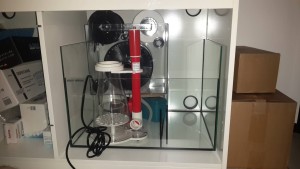 The Theiling Roller Mat is a new spin, on a tried and true filtration method. Sorry, I couldn’t resist, as the roller mat’s selling point is that it automatically spins, replacing debris laden cotton fabric with clean fabric. Mechanical filtration still remains a hallmark of maintaining ultra-clear reef aquarium water, and while some aquarists have abandon the use of filter socks, those of us obsessive about the clarity of our water, still use them on a full-time basis. The roller mat promises a more efficient and effective way to filter sediment and particles from water, while greatly reducing the work required to change, and clean, filter socks or foam pads. The device lives up to its promise, and using a simple design, maintains clean filter fabric while effectively pulling sediment out of aquarium water. However, it’s large size, exuberant price and overall design, makes it an imperfect solution for many reef aquarists.
The Theiling Roller Mat is a new spin, on a tried and true filtration method. Sorry, I couldn’t resist, as the roller mat’s selling point is that it automatically spins, replacing debris laden cotton fabric with clean fabric. Mechanical filtration still remains a hallmark of maintaining ultra-clear reef aquarium water, and while some aquarists have abandon the use of filter socks, those of us obsessive about the clarity of our water, still use them on a full-time basis. The roller mat promises a more efficient and effective way to filter sediment and particles from water, while greatly reducing the work required to change, and clean, filter socks or foam pads. The device lives up to its promise, and using a simple design, maintains clean filter fabric while effectively pulling sediment out of aquarium water. However, it’s large size, exuberant price and overall design, makes it an imperfect solution for many reef aquarists.
Mechanical filtration:
 Some aquarists ditched this standby in reef filtration long ago. Over the years, aquarium experts have suggested that mechanical filtration (mainly filter socks and sponge pads) traps debris, creating a place for aerobic bacteria to build-up, while releasing a steady stream of nitrates. In general, as long as the aquarist is diligent about replacing filter socks or pads, then it’s not typically an issue. While filter socks polish water of unsightly sediment, including un-eaten food, they don’t last long before needing replaced with a clean sock. On my reef, I am lucky to get more than three days from a filter sock. To keep up with the demand, I had over a dozen on hand, constantly rotating them. The real challenge comes when the socks need cleaned. Since the filter media is full of minute weaves and crevices, it’s nearly impossible to easily clean off seemingly caked in debris.
Some aquarists ditched this standby in reef filtration long ago. Over the years, aquarium experts have suggested that mechanical filtration (mainly filter socks and sponge pads) traps debris, creating a place for aerobic bacteria to build-up, while releasing a steady stream of nitrates. In general, as long as the aquarist is diligent about replacing filter socks or pads, then it’s not typically an issue. While filter socks polish water of unsightly sediment, including un-eaten food, they don’t last long before needing replaced with a clean sock. On my reef, I am lucky to get more than three days from a filter sock. To keep up with the demand, I had over a dozen on hand, constantly rotating them. The real challenge comes when the socks need cleaned. Since the filter media is full of minute weaves and crevices, it’s nearly impossible to easily clean off seemingly caked in debris.
This leads most aquarists to turn to un-scented bleach, which breaks up trapped debris, allowing it to be rinsed off. The problem, is that you’re left with a bleach soaked filter sock, not even remotely safe for use in a reef aquarium. In order to solve this problem, the socks then need soaked in a bleach absorber or chlorine assimilator. Even with ardent cleaning and maintenance, sooner or later filter socks (and foam pads) become some worn, and trapped with debris, that they must be replaced. Overall, the entire process is time consuming and pain staking, making it no surprise that many aquarists have abandon mechanical filtration, allowing debris to move through the system, eventually being removed via protein skimming or biological processes. In this scenario, it’s not uncommon for a reef tank’s water to perpetually have suspended debris floating around, and even take on a green or yellow tinge, caused by diluting sediment. Essentially, neither filter socks nor abandoning them is a perfect solution, to the problem of excess particles.
Enter the roller mat:
 German company Theiling is known for high quality, and high tech equipment, which covers the gamut from marine aquariums on down to reptile keeping. Theiling employs a team of engineers and biologists, who set out to solve the problem of aquarium debris, and devise a way to remove it, without the hassle of cleaning and maintaining filter socks. The child of that engineering love triangle is the roller mat. The device looks like an auto-top off reservoir, with two big rolls of filter fleece on top, and a large fleece covered canister in the center. At 17” left to right, 10” front to back, and 19” tall, the roller mat is large. In fact, it’s sheer size alone will likely disqualify it as a viable option for some aquarists, especially those that require equipment to be tucked away in a cabinet, out of sight. Considering that in order to use the roller mat via a gravity feed (arguably the most reliable way) it has to sit above the sump’s water level, placement of such a large device is even more problematic.
German company Theiling is known for high quality, and high tech equipment, which covers the gamut from marine aquariums on down to reptile keeping. Theiling employs a team of engineers and biologists, who set out to solve the problem of aquarium debris, and devise a way to remove it, without the hassle of cleaning and maintaining filter socks. The child of that engineering love triangle is the roller mat. The device looks like an auto-top off reservoir, with two big rolls of filter fleece on top, and a large fleece covered canister in the center. At 17” left to right, 10” front to back, and 19” tall, the roller mat is large. In fact, it’s sheer size alone will likely disqualify it as a viable option for some aquarists, especially those that require equipment to be tucked away in a cabinet, out of sight. Considering that in order to use the roller mat via a gravity feed (arguably the most reliable way) it has to sit above the sump’s water level, placement of such a large device is even more problematic.
However, if you have a fish room, filter room, or exceptionally large cabinet, the roller mat can mount above the sump, and despite its intimidating appearance, is very easy to get up and running. In addition to a gravity feed, the roller mat can be mounted externally, using a pump to move water into the unit and tubing to direct output. There is also an overflow drain, in the event the unit becomes clogged and the roller ceases function. Theiling, and the roller mat’s sole U.S. distributor Bulk Reef Supply, both recommend a gravity flow, as the most effective option. It’s important to remember, that the max flow rate for water entering the roller mat, is 600 gallons per hour. Also, the roller mat uses metric fittings, so finding plumbing to fit the standard fittings, is tough if not impossible in the U.S. However, Bulk Reef Supply sells a plumbing conversion kit for $ 19.99, which allows you to easily replace the metric fittings with standard U.S. sizes.
Water flows into the unit’s bottom, and begins filling the roller mat’s chamber. In order to reach the exit, water must pass over a large cylinder wrapped in filter fleece. In doing so, any suspended debris is removed, before water flows out the overflow and back into the tank. As the filter fleece becomes clogged with debris, the water level rises, until reaching an electronic float switch. When the switch trips, the roller mat spins, removing the dirty fleece while rolling out clean media, which opens flow back up, dropping the unit’s water level. It’s an ingenious design, and while watching it work, it’s clear the roller mat removes all the debris floating within water. In fact, it could be too effective, and if your supplementing or feeding your tank, it would be best to turn off the main pump, as the roller mat will remove all the particles. Within a few hours, my roller mat was spinning away, removing debris laden fleece, while bringing in clean. It’s worth noting that the roller mat’s design allows it to be very efficient. Instead of spinning out a pre-determined amount of new fleece, each time the switch is tripped, the roller mat slowly rolls out new media, opening up enough to allow water to drain. This design, ensures that fleece isn’t wasted.
Value:
 If you’re particular about sediment floating through your aquarium water, and not a fan of cleaning and maintaining filter socks, the roller mat is certainly worth a look. While the unit comes pre-installed with your first role of media, out of curiosity, I removed this and re-installed it, just to see how tough (or easy it was). Honestly, replacing the roller mat fleece is harder than setting it up, but even that wasn’t enough to disqualify it as a viable alternative to filter socks. Considering that 2/3 of the time, the roller mat will be taking care of itself, a fleece change here and there, shouldn’t turn anyone away.
If you’re particular about sediment floating through your aquarium water, and not a fan of cleaning and maintaining filter socks, the roller mat is certainly worth a look. While the unit comes pre-installed with your first role of media, out of curiosity, I removed this and re-installed it, just to see how tough (or easy it was). Honestly, replacing the roller mat fleece is harder than setting it up, but even that wasn’t enough to disqualify it as a viable alternative to filter socks. Considering that 2/3 of the time, the roller mat will be taking care of itself, a fleece change here and there, shouldn’t turn anyone away.
I imagine the biggest turn-off for most, will be the roller mat’s price. The unit itself (which includes one roll of fleece) runs $ 400, while the (essentially required) plumbing kit is an additional $ 19.99. An additional roll of fleece is $ 19.99 as well, and with shipping, the unit’s overall cost will best $ 450-500. That’s a hefty price to pay for convenience.
You could buy well over a dozen filter socks for less than half that price, greatly reducing the length of time between filter sock cleanings. Overall, I think the roller mat’s cost and size, disqualify it as a need (or want) for 95% of aquarists. However, the small sliver that demands crystal clear water, and likes to automate aquarium maintenance, will probably find a friend in the roller mat.










0 Comments